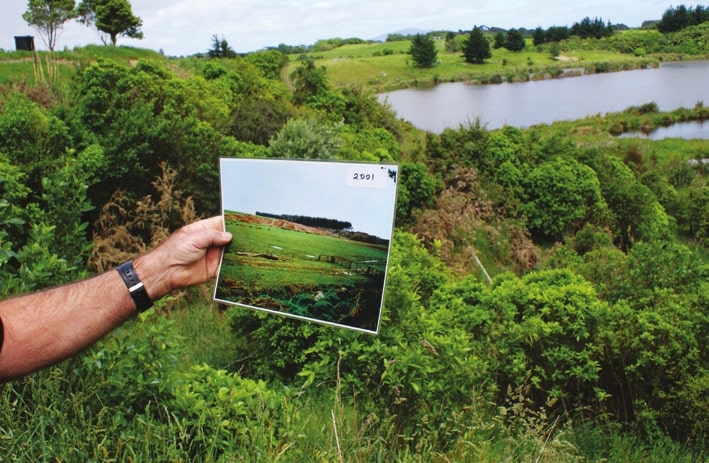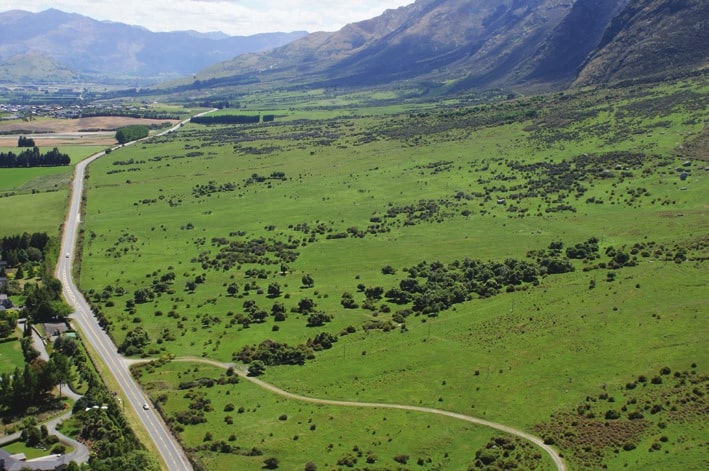Forever protected: QE II National Trust a trusted promise
Neil Cullen, New Zealand Tree Grower February 2021.
In July last year I was appointed by then Minister Eugenie Sage, along with Karen Schumacher from Taranaki and Alan Livingston from Waikato, to the board of the QE II National Trust. The other appointed member, Bruce Wills, is the new Chairman. Two elected members, Graham Mourie and Donna Field, make up the rest of the board.
The QE II Trust was named in honour of our head of state because the forming legislation was passed in 1977, the silver jubilee of the Queen’s reign. For over 40 years the QE II Trust has been setting up and monitoring covenants on private land to protect our natural and cultural heritage.
The driving force behind the establishment of the QE II Trust was Gordon Stephenson and his wife Celia. They were English immigrants who owned a dairy farm in the Waikato and wanted to ensure the remnants of native bush they had fenced off would stay protected once they sold the farm. Theirs was the first covenant registered in 1979. Since then, another 4,700 covenants have been registered and with more than 300 currently going through the process, there will soon be more than 5,000 of these protected areas on private land across the country, covering more than 190,000 hectares.
National priorities
The process of negotiating a covenant takes an average of two years. It usually starts with a land owner contacting one of the 26 regional representatives who are spread around the country. The easiest way to find your nearest representative is via the website www.qeiinationaltrust.org.nz. These regional representatives are, in many ways, the unique strength of the organisation as they have detailed knowledge of the plants, animals and geography of their areas and are well trusted by land owners. They will give an initial opinion on whether the application for a covenant should proceed.
There are four national priorities used to guide the covenant proposals. They are −
- Protects indigenous vegetation in land environments that have 20 per cent or less remaining in indigenous cover
- Protects indigenous vegetation associated with sand dunes and wetlands
- Protects indigenous vegetation associated with originally rare terrestrial ecosystem types not already covered by the first two priorities
- Protects habitats of New Zealand’s most threatened indigenous species of plants and animals.
The QE II Trust has an understanding with the Minister of Conservation that at least 90 per cent of new covenants will meet one or more of the four priorities. In addition to protecting biodiversity, cultural, educational, landscape and recreational values can also be protected. Teams of ecologists and lawyers based in Wellington assess the applications and help the representatives produce the individual terms and conditions for each covenant. These allow for each land owner’s circumstances and aspirations while still meeting the overall objectives of protection, preservation and enhancement.
Each covenant is a partnership between the QE II Trust and the land owner, with the former arranging the legal work, surveying, paying half of any initial fencing required and providing monitoring and advice on the management of the protected area. The land owner still owns and manages the covenanted land and agrees to maintain fences, organise pest control and generally meet the conditions set down in the original agreement.
The covenant agreement is registered on the land title so it remains in force no matter how many times the ownership changes.
Protected forever
Forever protected is the underlying motto of the QE II Trust and is something everyone from the directors down are prepared to defend. With increasing numbers of properties with covenants changing hands, a proportion of the new owners may not have the same enthusiasm for the protected area as the original covenantor. Where blatant and persistent abuse of a covenant takes place, court action is possible. Although this is a reluctant last resort, in all cases where this has happened, the courts have found in favour of the QE II Trust and upheld the original conditions of the agreement. Only where over-riding legislation such as the Public Works Act takes effect can the covenant agreement be set aside.
Many NZFFA members already have covenants on their land because they have places which they treasure and that they want to be protected beyond their tenure. As well as having that legacy effect, there is the added bonus of having the input of the local QE II Trust representative who can run their experienced and knowledgeable eyes over each covenant and identify plants and animals which the land owner may not be aware of.
Many regional and district councils do not charge rates on areas which are covenanted. With increased public pressure on a licence to operate for farmers and foresters, and with farm environment plans becoming universal, having a covenant is a strong indicator that you are serious about protecting the environment and are a true guardian of the land. Covenants can often be part of a larger network linking Department of Conservation reserves or other covenants in an area to provide stepping stones or corridors for birds between scattered areas of their natural habitat.
Value
Value is not determined by area. A quick calculation will tell you that the average covenant size is 38 hectares but this is distorted somewhat by our largest covenant known as Mahu Whenua, which totals 53,000 hectares. There are many valuable covenants which are less than one hectare in area. Of the 27 most recently approved covenants six are less than two hectares including two adjacent ones in Rakiura. Although small areas, these Stewart Island covenants contain at least 60 native plant species including sphagnum moss and the animals include kiwi, kaka and kakariki.

So, do not be put off if your treasured area seems insignificant. It may still contain unique or endangered ecosystems that local representatives will soon identify. The Mahu Whenua covenants were registered in 2015 and lie between Lake Wanaka and Arrowtown. They cover four adjoining stations – Motatapu, Mount Soho, Glencoe, and Coronet Peak – Crown Pastoral Leases owned by reclusive record producer and composer Mutt Lange. This is a high-country landscape with related biodiversity, recreational, historic, and cultural values.
In many ways this area is a testing ground for managing the destocking of high-country tussock land with the associated problems of heightened fire risk and wilding tree spread. The owner has spent vast amounts on the control of wilding conifers and continues to work with local groups which have additional government funding for conifer control.

Otago University is conducting trials here and at High Peak Station in Canterbury on the direct drilling of native tree seeds to see if the reversion of damper high-country areas to indigenous forest can be helped to speed up. Initial results indicate that more work needs to be done on mycorrhiza demands and weed control for this to have more success.
On 25 November this year, at a ceremony at their home, Jillian and Dick Jardine announced that they intended to give their 900-hectare farm Remarkables Station to the QE II Trust. The handover will take place in 2022 when the centenary of the Jardines as owners of the station is reached. The covenant which will be registered over the farm will ensure that it remains as an active mixed stock farm and will not be subject to any further subdivision or settlement. More than 100 hectares at the southern end of the station has been retired from grazing for some time and is steadily reverting to native vegetation.
Accepting this generous gift was not an easy decision for the QE II Trust board because running a farm is not part of the core business, but the landscape values of the property at the base of the Remarkable Range are spectacular. The gift is significant for the Wakatipu area because open landscapes in the area come under increasing pressure from population growth and tourism. It is hoped that other land owners in the area may follow the lead of Mutt Lange and the Jardines in using the QE II Trust to protect their iconic landscapes.
Core funding comes from government via the Department of Conservation and has not increased for several years. The QE II Trust registered 110 new covenants in the last year but without additional funding any major increase in annual covenant numbers is constrained. In saying that, the Jobs For Nature programme announced by the government in the current budget included mention of the QE II Trust in respect of protection of biodiversity. The board hopes that a Jobs For Nature package supporting its work will be announced in the near future.
A recent paper in the New Zealand Journal of Ecology by Professor David Norton highlights the significance of sheep and beef farms to conservation of native vegetation in New Zealand. It noted that they contain a quarter of the remaining native vegetation and 17 per cent of remaining native forest. As the major provider of legal protection on private land, the QE II Trust has a vital role in complementing public conservation land by increasing the areas protected and especially the landscape connectivity of native habitat.
Neil Cullen is a past president of the NZFFA and is a member of the Executive.

 Farm Forestry New Zealand
Farm Forestry New Zealand